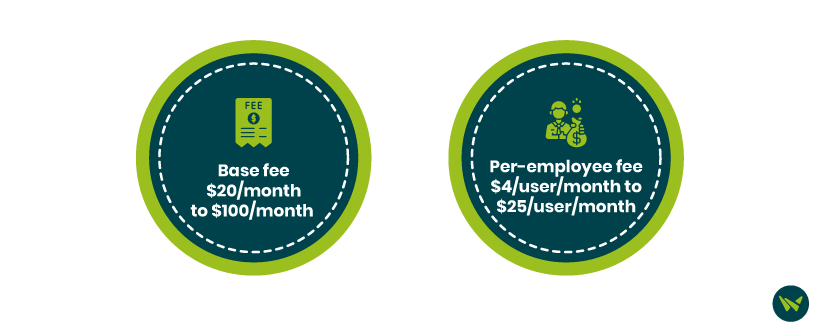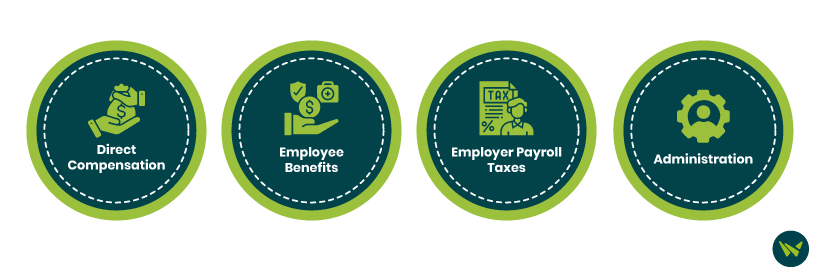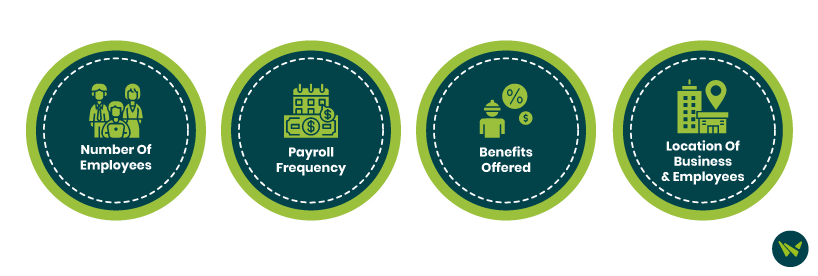
Payroll may appear to be straightforward, but for small businesses, it's one of the most complex and variable expenses. Beyond employee paychecks, it includes taxes, benefits, software costs, and compliance obligations. Whether you're a small business owner seeking to cut costs or exploring various payroll solutions, understanding the full scope of payroll costs is crucial for strengthening your financial position and making informed business decisions.
This guide examines the average cost of payroll for small businesses, along with several factors that influence these costs.
Knowing the average cost of payroll allows small business owners to plan their budgets more effectively and select the most efficient payroll solution. Expenses can vary significantly based on factors such as employee count, the payroll method chosen, and the types of benefits offered. Here’s an overview of what most small businesses can expect from payroll software:
Monthly Payroll Software Costs
Most cloud-based payroll software providers offer flat monthly fees plus a per-employee rate. On average:

- Base fee: $20/month to $100/month
- Per-employee fee: $4/user/month to $25/user/month
For example, a business with 10 employees might pay anywhere between $60 and $250/month, depending on features like direct deposit, tax filing, and integrations.
Total Compensation Load
According to the U.S. Small Business Administration (SBA), total payroll costs can typically range from 1.25 to 1.4 times an employee’s base salary. This estimate accounts for additional expenses, including payroll taxes, insurance contributions, retirement benefits, and paid time off.
For instance, an employee earning $50,000 could cost a business between $62,500 and 70,000 annually.
In addition to these employee-related expenses, businesses must also factor in the cost of payroll services. These platforms automate tasks like tax filing, direct deposit, and compliance—but their pricing varies based on provider, company size, and features selected. Below is a snapshot of leading payroll service providers and their estimated fees:
Software | Free Trial | Pricing |
No | Starting from $25/month/employee | |
Lano | No | Starting from 3€/employee/month |
Velocity Global | No | Starting from $599/employee/month |
No | Starting from $29/employee/month | |
No | Starting from $49/contractor/month |
Payroll costs encompass all expenses related to compensating employees for their work. These costs are influenced by factors such as business size, payroll frequency, and the complexity of compliance requirements.
For small businesses, it’s crucial to understand each cost category to accurately estimate total compensation and ensure tax compliance. Here’s a breakdown of the primary payroll cost components:

1. Direct Compensation
This represents the wages or salaries paid directly to employees for their work, such as salaries, hourly wages, overtime pay, commissions, and bonuses. It’s the most straightforward payroll cost, but it varies depending on the job role, experience, and the number of hours worked. Bonuses, commissions, and overtime pay can significantly increase the total beyond the base salary—often more than businesses anticipate.
2. Employee Benefits
Employee benefits are non-cash offerings provided to employees, such as health insurance, paid time off, and wellness programs. The expenses associated with offering these benefits comprise a significant portion of the overall payroll costs. This includes employer contributions to health coverage, retirement plans, paid leave, life and disability insurance, and other employee perks.
3. Employer Payroll Taxes
Payroll taxes are a percentage of employee wages that businesses are required to pay to federal and state governments. Employers must withhold the appropriate amount of employment taxes from each employee’s paycheck, including Social Security and Medicare. It’s important to factor employer payroll taxes into your total payroll expenses—they can significantly increase overall labor costs.
4. Administration
Administrative expenses refer to the various costs associated with managing payroll, distributing employee compensation, maintaining pay equity, and benefits. Typical administrative payroll costs include calculating and managing employee wages, processing payments through direct deposit, submitting payroll taxes to the appropriate government agencies, and filing necessary tax forms and reports.
Payroll expenses aren't uniform—they depend on a range of internal and external factors. By understanding these variables, small businesses can more accurately forecast payroll costs and avoid unexpected budget overruns.

1. Number Of Employees
Headcount is the most straightforward factor influencing payroll costs. Every new hire adds to overall expenses through increased wages, taxes, and benefit obligations. Additionally, many payroll systems charge on a per-employee basis, meaning that as your team grows, so do your software or service fees.
2. Payroll Frequency
Running payroll weekly is more expensive than doing so monthly, as each cycle involves processing time, system usage, and sometimes transaction fees. Reducing frequency can help cut administrative costs. For example, if your payroll provider charges $4/employee/pay period and you run payroll bi-weekly, the cost comes to $8/employee/month. However, if you switch to weekly payroll, the amount doubles to $16/employee/month.
3. Benefits Offered
Providing comprehensive benefits, such as health insurance, retirement plans, and paid time off, can substantially increase overall payroll expenses.
4. Location Of Business And Employees
Payroll costs vary by state due to differences in minimum wage laws and tax regulations. Businesses operating in high-cost states or managing remote teams across multiple regions may face increased compliance requirements and processing fees.
Payroll costs can escalate quickly once taxes, benefits, and administrative fees are included. Managing payroll is an essential part of running a business—but it doesn’t have to be complicated or costly. With the help of payroll software, businesses can streamline their payroll process, save time, and reduce expenses.
